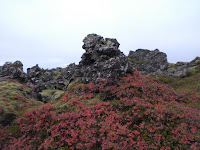Over
the last twelve years I have written five crime novels set in Iceland. I have
visited the country many times, I have spoken to dozens of Icelanders, taken
loads of photographs and mumbled for hours into a tape recorder in the wind and
rain.
I have taken notes. Boy, have I taken notes. I’m quite proud of the way I have organized them. I have a massive Word file of 450 pages (over 200,000) words, all split into sections and subsections for easy reference. So, if I want to describe the café Mokka in Reykjavík, for example, or the effect of the sunlight and clouds on Mount Esja, I can look it up right away.
2. When an Icelander gets a piece of extraordinary luck he shouts “Hvalreki!”, which means “Beached whale!”
3. Iceland has had three Miss Worlds, not bad for a country with the same population as Coventry, which has had none (yet).
4. Iceland is the only country in medieval Europe to be governed without a ruler. Between its settlement in 874 and 1264 Iceland was governed at an annual open-air meeting of the chieftains called the Althing, held on the floor of the rift valley at Thingvellir
5. An analysis of Icelanders’ DNA shows that 75% of their male ancestors were mostly Norwegian, but 62% of their female ancestors were British or Irish. That’s what a couple of centuries of raping and pillaging will do for the bloodstock.
6. An Icelandic family of four can have four different last names. For example: Jón Gunnarsson (father), Björk Ragnarsdóttir (mother), Magnús Jónsson (son) and Anna Jónsdóttir (daughter).
7. Until 1987 there was no television in Iceland on Thursday nights. The TV guys needed a day off like everyone else.
8. Despite being so far north, the temperature doesn’t vary very much. The mean temperature is 2 degrees Celsius in January and 13 degrees Celsius in June. Basically, the weather is pretty bad all year round.
9. Iceland is teeming with “hidden people” who live in rocks. Roads have been diverted to avoid these dwellings. A higher proportion of supporters of the Progressive Party believe in hidden people than supporters of other political parties. Everyone’s granny has spoken to one.
10. Icelandic still uses two letters from old English, thorn (þ) and eth (đ). These were introduced to Iceland by English monks in the eleventh century.
11. 89% of houses in Reykjavík are heated using steam bubbling up from the earth’s core. The hot water in Reykjavík smells vaguely of sulphur.
12. An Icelander was the first European to discover America (Leifur Eiríksson)
There
are many, many more.
At heart, I’m not a non-fiction writer, I’m a storyteller. So I decided to tell the story of how and why I set a detective series in Iceland. The stakes, for me at least, were high. After writing eight financial thrillers, I was looking for a new setting for my novels. I knew nothing about Iceland, and I wasn’t entirely certain I would be able to discover enough about the country to write crime novels set there. It was a risk.
In Writing in Ice, I describe all that I did discover: Iceland’s people, its culture, its breath taking landscape, its history, its literature, its myths and its music. I also show how I put together a detective series in a foreign country: creating Magnus my detective, researching characters, how to describe a setting and an atmosphere.
When I wrote my first Magnus novel, Where the Shadows Lie, there was only one internationally known Icelandic crime writer – Arnaldur Indridason. Now there are many more: Yrsa Sigurdardóttir, Lilja Sigurdardóttir (no relation), Ragnar Jónasson, Quentin Bates (who is British like me, but knows Iceland much better than I do) and more emerging every year. Which isn’t surprising, really, since it’s brilliant place to write about.
By this point you may be asking yourself, what is the point of a foreigner writing about Iceland when there are so many Icelanders who do it so well?
There is an Icelandic expression: “Glöggt er gests augad”, which roughly translates to “Clear is a guest’s eye.” There are some things a foreigner can see and describe, which a native won’t. There is so much extraordinary in Iceland, that it all seems ordinary to an Icelander. But I can point it out.
That’s why I made my detective, Magnus, an Icelandic-American. He moved to Boston when he was twelve and became a Boston homicide detective. So when he returns to Iceland, he sees his own country through the eyes of a guest. Through my eyes.
Writing in Ice is the story of how I learned to see Iceland. More than that, it’s the story of how I fell in love with the country.
Michael Ridpath is the author of the Magnus Iceland Mysteries. His book Writing in Ice: A Crime Writer’s Guide to Iceland is published 1 July 2021.
If you had to choose a new location for a crime series, where would you look? Michael Ridpath had to do just that. He chose Iceland, a country of fjords, glaciers and volcanoes, of long, manic summer days and long, sinister winter evenings, a place where everyone is on Facebook and everyone's grandmother has spoken to an elf. This is his account of researching the country: the breathtaking landscape, its vigorous if occasionally odd people, the great heroes and heroines of its sagas, and (of course) those troublesome elves; with a little bit thrown in about how to put together a good detective story.
All pictures © Michael Ridpath
1. Michael Ridpath
2. Jökulsárlón Lagoon
3. The Berserker’s Lava Field, West Iceland





No comments:
Post a Comment